 MEET THE SCULPTURES
MEET THE SCULPTURES
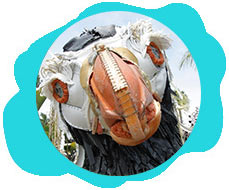
Sebastian James the tufted puffin
Sponsored by : 
Tufted Puffins are diving birds and swim with their wings underwater while catching fish, their primary food source.
Like many ocean birds, puffins have been known to mistake plastic for food. This fills them up with plastic and can lead to starvation. Entanglement in abandoned fishing gear can also be a deadly encounter.
• Dimensions Diameter 9' 4" L x 7' 11" W x 9' H
• Weight 1200 lbs
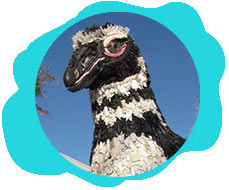
GERTRUDE THE PENGUIN
Magellanic penguins like Gertrude live in South America and on a few islands in the southern ocean. Like many of their flying cousins, these penguins migrate from winter to summer locations and will often return to the same breeding site.
Oil pollution continues to be the main threat to this species and kills thousands of penguins every year.
• Dimensions 7' 5" L x 6' 5" W x 8' 9" H
• Weight 1000 lbs
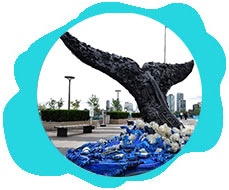
GRACE THE HUMPBACK WHALE
Humpback whales swim through every ocean in the world. They can grow up to 50 feet and adults can weigh 40 tons. These giants of the deep are an iconic animal for many people who love the ocean, but not long ago they were an endangered species. Hunted to the brink of extinction by whalers, this species now represents one of the most successful comeback stories in the ocean and their numbers continue to increase.
In order to ensure these whales repopulate the oceans they once roamed, it is our responsibility to ensure their environment is free from another man-made threat, our trash.
• Dimensions 7' 5" L x 6' 5" W x 8' 9" H
• Weight 1000 lbs
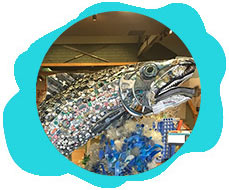
NORA THE SALMON
Each year, millions of salmon travel down streams and rivers to get to the ocean. Millions of pounds of plastic also travel down waterways every year on the way to the sea. Over 80% of trash in the ocean comes from land. You can help stop the plastic migration by picking up trash on land to ensure it never reaches the water.
• Dimensions 5' 11" and 6' 6" H
• Weight 800 lbs
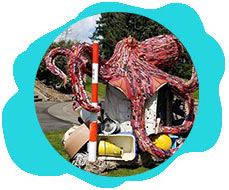
OCTAVIA THE OCTOPUS
Although they live an average of just four years, Giant Pacific octopuses can grow over 20 feet in length.
The octopus is one of the most intelligent species in the ocean. It has the ability to problem solve, use tools and communicate by changing colours. In order to keep these incredible creatures healthy, we need to keep their environment clean.
• Dimensions 12'L x 8'W x 10'H
• Weight 1600 lbs
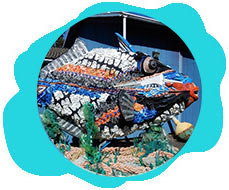
RUFUS THE TRIGGERFISH
There are 40 species of triggerfish swimming in oceans throughout the world. Using their powerful jaws and sharp teeth, triggerfish are able to eat urchins, mollusks and event scrape algae off of rocks. Their bite marks have also been seen on floating plastics and plastic pieces that have been found in their stomachs.
• Dimensions 14' L x 6' W x 9' H
• Weight 1500 lbs
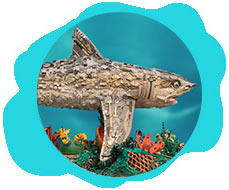
SYLVIA THE SILVERTIP SHARK
The Silvertip Shark is found mostly in the Pacific and Indian Oceans in warmer and shallow waters. It tends to search for prey around coral reefs. Unfortunately, the Silvertip is at risk of being added to the endangered species list. It is hunted commercially for its smooth skin, liver oil, and meat. Plastic pollution is also a threat. Sharks can ingest plastic either directly or by eating other fish that have ingested plastic.
• Dimensions 11'5"L x 5'4"W x 6'3"H
• Weight 1000 lbs
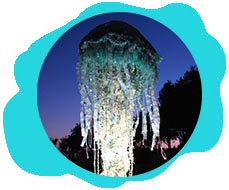
GIANT SEA JELLY
Sea jellies have an incredibly unique life cycle which has helped these animals survive more than 500 million years. They spend the majority of their existence growing on the sea floor as hydroids before they bud off and float through the water.
In modern oceans, plastic bags strongly resemble sea jellies in their floating life stage. Hungry turtles that feed on sea jellies often cannot tell the difference. This deadly mistake is now one of the biggest threats to sea turtles worldwide.
• Dimensions Stand – 2’ W x 12’ H Dome – 6’ Diameter 3’ H
• Weight 2000 lbs
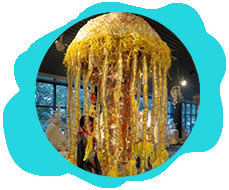
BAY SEA JELLY
Sea jellies have an incredibly unique life cycle, which has helped some jelly species survive more than 500 million years. The sea jelly life cycle includes two different stages: a polyp attached to the sea bottom and a medusa that’s usually free-swimming. The polyps produce the medusa. In turn, the medusa spawn – a common form of mating for aquatic animals. Their offspring result in a new polyp.
In modern oceans, plastic bags strongly resemble sea jellies in this floating life stage. Hungry turtles often cannot tell the difference. This deadly mistake is now one of the biggest threats to sea turtles worldwide.
• Dimensions Diameter 6' x 10' H
• Weight 200 to 300 lbs
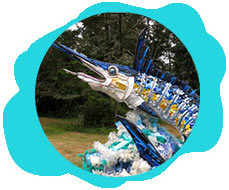
FLASH THE MARLIN
Marlin are some of the fastest swimmers in the world and a highly sought after sport fish. Blue marlin, the most tropical of the 10 marlin species, cruise through the open ocean often covering hundreds of miles in their migration patterns. During their travels, they pass through waters inundated with plastic pollution. Clean water is vital to keeping marlin healthy.
• Dimensions Diameter 10' L x 7' 8" W x 8' H
• Weight 700 lbs
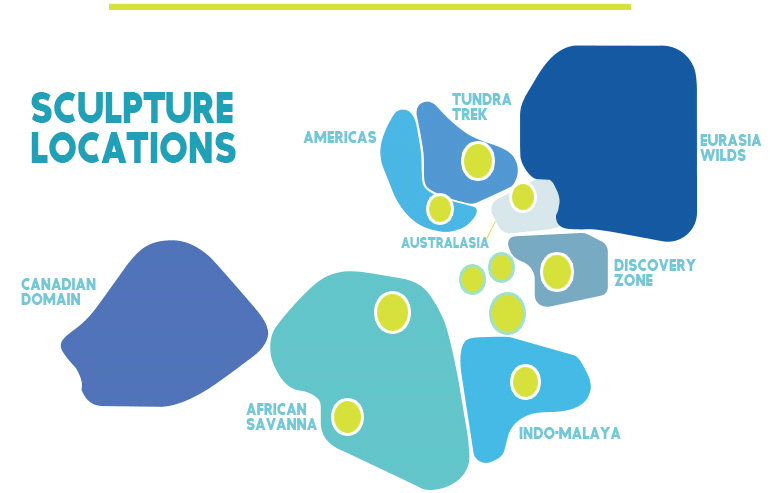
SEBASTIAN JAMES THE TUFTED PUFFIN
SPONSORS OF WASHED ASHORE



